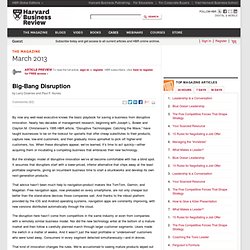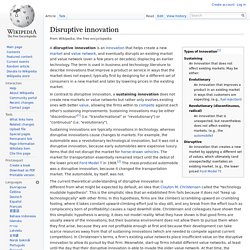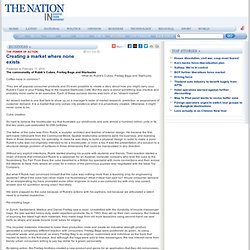

Big-Bang Disruption. By now any well-read executive knows the basic playbook for saving a business from disruptive innovation.

Nearly two decades of management research, beginning with Joseph L. Bower and Clayton M. Christensen’s 1995 HBR article, “Disruptive Technologies: Catching the Wave,” have taught businesses to be on the lookout for upstarts that offer cheap substitutes to their products, capture new, low-end customers, and then gradually move upmarket to pick off higher-end customers, too. When these disrupters appear, we’ve learned, it’s time to act quickly—either acquiring them or incubating a competing business that embraces their new technology.
But the strategic model of disruptive innovation we’ve all become comfortable with has a blind spot. That advice hasn’t been much help to navigation-product makers like TomTom, Garmin, and Magellan. The disruption here hasn’t come from competitors in the same industry or even from companies with a remotely similar business model. Disruptive innovation. Sustaining innovations are typically innovations in technology, whereas disruptive innovations cause changes to markets.

For example, the automobile was a revolutionary technological innovation, but it was not a disruptive innovation, because early automobiles were expensive luxury items that did not disrupt the market for horse-drawn vehicles. The market for transportation essentially remained intact until the debut of the lower priced Ford Model T in 1908. The mass-produced automobile was a disruptive innovation, because it changed the transportation market.
The automobile, by itself, was not. The current theoretical understanding of disruptive innovation is different from what might be expected by default, an idea that Clayton M. The work of Christensen and others during the 2000s has addressed the question of what firms can do to avoid displacement brought on by technological disruption. History and usage of the term[edit] 5 Examples Of Disruptive Innovation. Six Keys to Building New Markets by Unleashing Disruptive Innovation. Managers today have a problem.

They know their companies must grow. But growth is hard, especially given today's economic environment where investment capital is difficult to come by and firms are reluctant to take risks. Managers know innovation is the ticket to successful growth. But they just can't seem to get innovation right. When companies keep improving their existing products and services to meet their best customers' needs, they eventually run into the "innovator's dilemma. " Recent research indicates these problems are systemic. Managers typically grow impatient when we tell them this. The problem is, managers all too frequently use a one-size-fits-all theory.
Drawing on the work of a number of thoughtful researchers as well as our own work, we are exploring a set of theories that can help managers respond to the ever-changing circumstances in which they find themselves. How to create new market opportunities. In a highly competitive business environment, the winning strategy may not be to carve up your opponent, but instead to create an entirely new market.

This way of completely redefining the market, known as “Blue Ocean Strategy,” was developed by W. Chan Kim and Renee Mauborgne. It conceptualizes business not as an entity that can only benefit from another’s loss, but rather as a font of innovation that succeeds because it constantly seeks ways to provide something of benefit not only to itself, but to its customers. So how does one learn how to identify markets, how to enter them, and how to keep the profits flowing without resorting to either cut-throat cost wars or niche market specialization? How to Evaluate and Identify Markets There are two main market types, known as Red Ocean and Blue Ocean. Red Ocean Red ocean refers to a situation where the market and the "winning" strategies are predefined. Blue Ocean. Creating a market where none exists. What do Rubik's Cubes, Freitag Bags and Starbucks Coffee have in common?

They are all popular consumer products and it's even possible to create a story about how you might carry your Rubik's Cube in your Freitag Bag to the nearest Starbucks Cafe. But this story is about something less intuitive and probably more useful to an executive. Each of these success stories was born of an "absent market". An absent market is one that fails to show up on a manager's radar of market research, prediction or assessment of customer demand.
It is a market that only comes into existence when it is proactively created. Cube creation It's hard to believe the blockbuster toy that frustrated our childhoods and sold almost a hundred million units in its first two years just celebrated its 25th birthday. The father of the cube was Erno Rubik, a sculptor, architect and teacher of interior design.
Without any explicit intentions, Rubik started sharing his puzzle with students and friends. 60-Second Guide to Creating a Market Niche. Starbucks did it.

So did Sam's Club. For that matter, McDonald's did, too. They carved themselves a successful business niche. When Starbucks came on the scene, it raised coffee from a mere beverage to a culture in its own right. Warehouse clubs like Sam's made shopping in bulk fashionable and before McDonald's, fast food was downright slow.